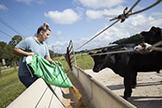Image Alternative Text – ADA Compliance
Providing content in ways all Florida residents can consume is essential. It is also the law. Over 28% of people in Florida have some sort of disability[1] that may prevent them from reading websites and electronic documents. It is our responsibility to provide our content in formats these individuals can easily access. One aspect of ADA compliance is providing Alternative Text (Alt-Text) for images and illustrations when distributing digital content like websites and PDF files.
What is Alt-Text?
Alt-Text is the text that describes images or illustrations embedded in images. These descriptions enable people with vision impairments to know what sighted people can see in the document. How you enter alt-text depends on the final output. WordPress and T4 allow you to enter alt-text on each image.
It gets more complicated when creating PDFs to send out to your clientele. The UF/IFAS Communications Graphic Design staff can assist on most projects that we design for you. We utilize Adobe InDesign and Adobe Acrobat to add alt-text and to build ADA-compliant files. Some things we take into consideration besides alt-text are color contrast, reading order, and content hierarchy.
Tips for Writing Alt-Text
- Review the image to understand it and how it relates to the content in the document.
- All images and illustrations that provide information need to have Alt-Text.
- Decorative visuals can be excluded.
- Be concise.
- Describe the main elements of the image in as few words as possible.
- Exclude details that are not relevant to the reader’s understanding of the image.
Examples
Photo Example |
Alt-Text |
 |
A black cow watching a woman fill a cattle feed trough. |
 |
A place setting with a meal of red sauced chicken, green beans, and ravioli. |
 |
Inchworm pest on the industrial hemp plant. |
[1] https://www.cdc.gov/ncbddd/disabilityandhealth/impacts/florida.html
Featured image by rh2010 – stock.adobe.com
 1
1
